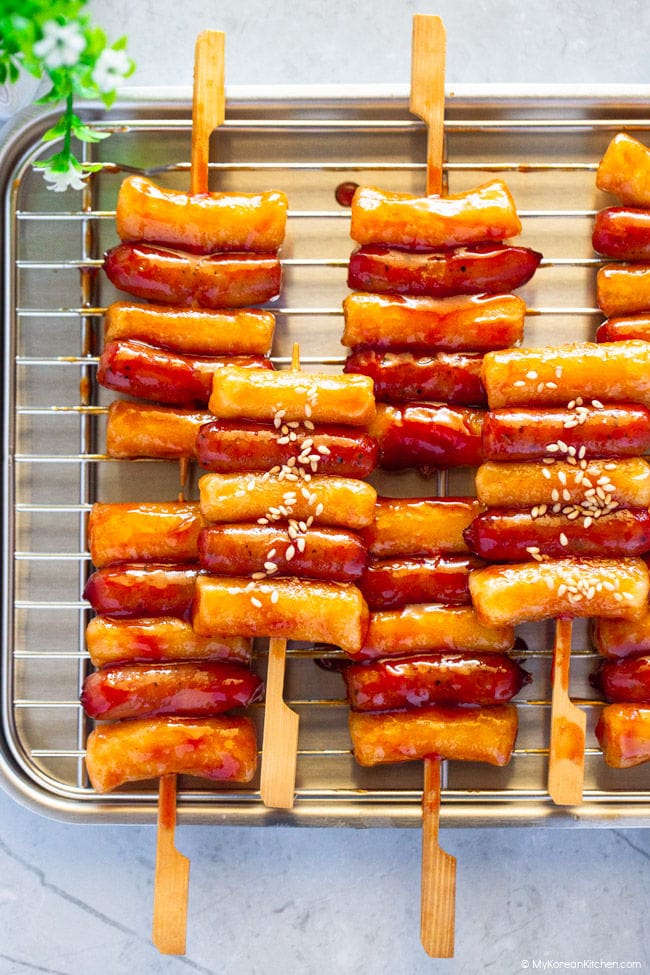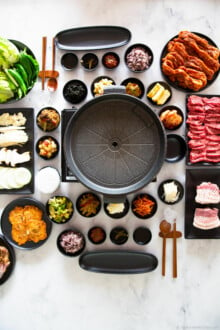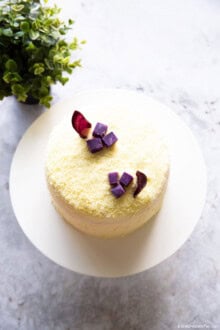Do you like rice cakes? If so, treat yourself to the irresistible flavors of these Tteok Kkochi! With their crunchy texture and incredible taste, you won’t be able to resist these rice cake skewers! Learn how to make them at home!
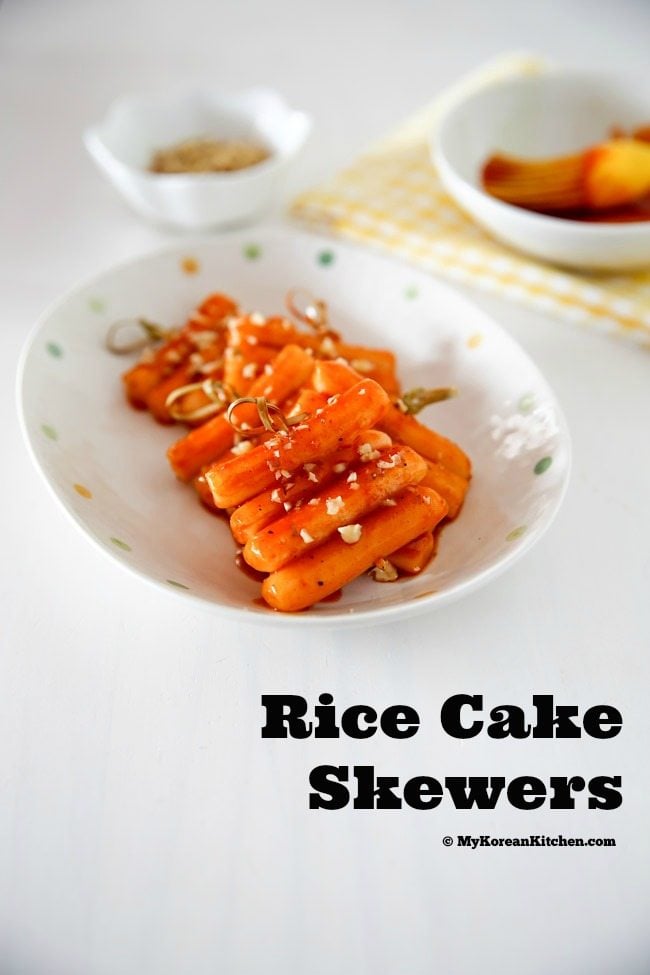
What is Tteok Kkochi
Tteok kkochi (also spelled as Tteokkochi, 떡꼬치) is a popular Korean dish made from soft and tender rice cakes skewered together, pan-grilled or deep-fried, and then brushed with a sweet, tangy, and spicy sauce. It’s simple yet delicious and can be served as a snack or an appetizer.
Some Facts About Korean Rice Cake Skewers (Tteok Kkochi or Tteokkochi)
- Korean rice cake skewers are one of the most popular Korean street food. You can see them a lot amongst street vendors in Korea.
- They are made with the same type of rice cakes that is also used in tteokbokki (Korean spicy rice cakes, 떡볶이). This rice cake is called garaetteok (가래떡).
- They are made by skewering a few soft rice cakes onto a skewer, pan-grilling them or deep-frying them, and then brushing the somewhat addictive, sweet, tangy, and spicy sauce on both sides of the rice cakes.
- The outer texture is slightly crunchy (like potato chips) and the inside is soft and chewy.
- It has been more than two decades since I was a high school student in Korea, and the cost of one skewer back then was around 500 won (approximately US 40 cents). Now, that same skewer costs 1000 won (around 80 cents). So, what do you think? Is this price tag too steep or an absolute bargain?

Why Make It at Home
Making tteokkochi at home was a real treat for my family this week. It took me back to my days in Korea and those fond memories. For my toddler, I made a special non-spicy, savory sauce that she absolutely adored! She refused to share it with her father, too—it was all hers! Seeing how excited she got about the dish warmed my heart.
You can also create lasting memories with your family—it’s a fun activity everyone can enjoy. What’s more, it’s a great way to experience an authentic Korean street food snack without having to go outside, and you can choose your preferred flavor options!
Other Korean Street Food You Might Like
Korean street food provides a marvellous experience for your taste buds! Check out my top picks below and start exploring all that Korean street food has to offer!
- Korean Corn Dog
- Dakkochi (Korean Chicken Skewers)
- Korean Popcorn Chicken
- Tteokbokki (Spicy Rice Cake)
Ingredients for Tteok Kkochi (4 servings as a snack)
Main
- 32 pieces of Korean rice cakes (garaetteok, 가래떡)
- Some cooking oil (I used rice bran oil)
- 1 to 2 Tbsp crushed nuts of your choice to garnish (I used walnuts. Peanuts, almonds or even sesame seeds are also a popular choice.)
Spicy, sweet and sour sauce (Original style) – mix these in a bowl
- 1 and 1/2 Tbsp tomato sauce/ketchup
- 1 Tbsp Korean chili paste (gochujang)
- 1 Tbsp honey
- 1/2 Tbsp soy sauce
- 1 tsp dark brown sugar
- 1 tsp sesame oil
- 1/4 tsp minced garlic
Savoury sweet sauce (Optional, Kids friendly style) – mix these in a bowl. This sauce is only enough for about 16 pieces of rice cakes.
- 1/2 Tbsp honey
- 2 tsp soy sauce
- 1 tsp sesame oil
- 1 tsp sesame seeds
*1 Tbsp = 15ml
** If you want to learn more about Korean cooking ingredients, check my essential Korean cooking ingredients list!
How to Make Tteok Kkochi (Korean Rice Cake Skewers)
1. Blanch the rice cakes in hot boiling water for about 30 seconds to soften them. Drain the water and run cold tap water on the rice cakes. Drain and pat dry the rice cakes with some kitchen paper to avoid oil splash during cooking. (If your rice cakes are fresh and soft already, skip this step.)
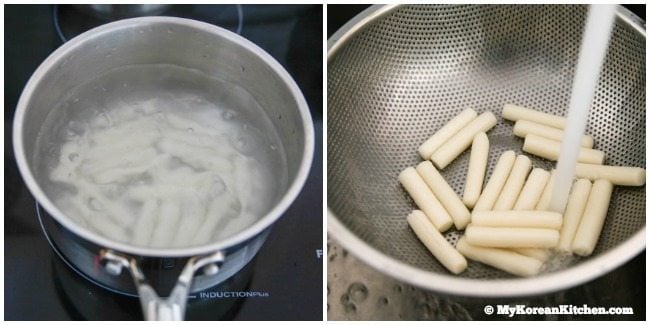
2. (While boiling the water above) Heat the sauce in a separate sauce pan briefly (for 20 to 30 seconds) to dissolve the sugar and honey and thicken the sauce a bit. Constantly stir it to avoid burn.
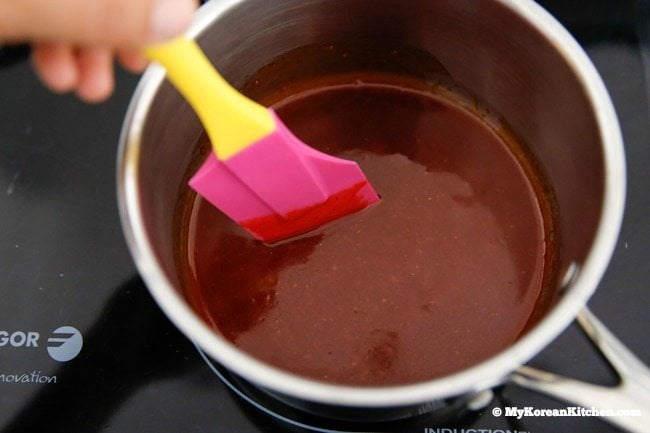
3. Put the rice cakes on the skewers. (Number of rice cakes on the skewer will depend on the length of the skewer. But make sure that it will fit nicely in your frying pan.)
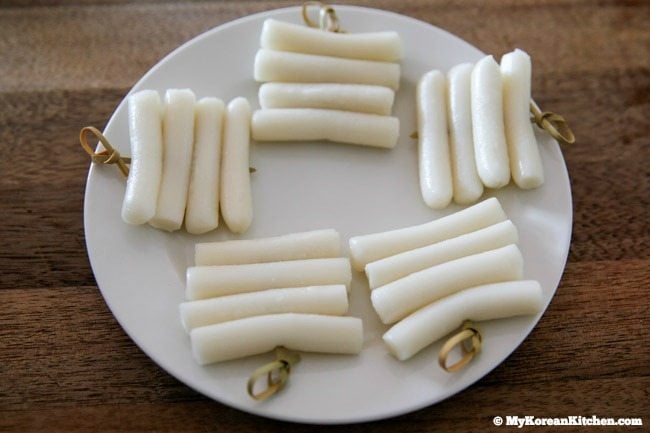
4. Add some cooking oil in a well heated pan and grill both sides of the rice cakes on medium high heat for about 1 min each. Take them out and brush the sauce on both sides of the rice cakes. (Alternatively you can dip the rice cakes into the sauce bowl if it’s deep enough.)
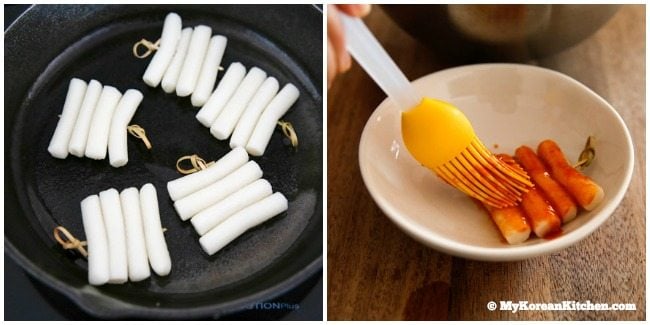
5. Garnish with your choice of crushed nuts and serve. Enjoy these delicious treats, either warm or cooled to room temperature.
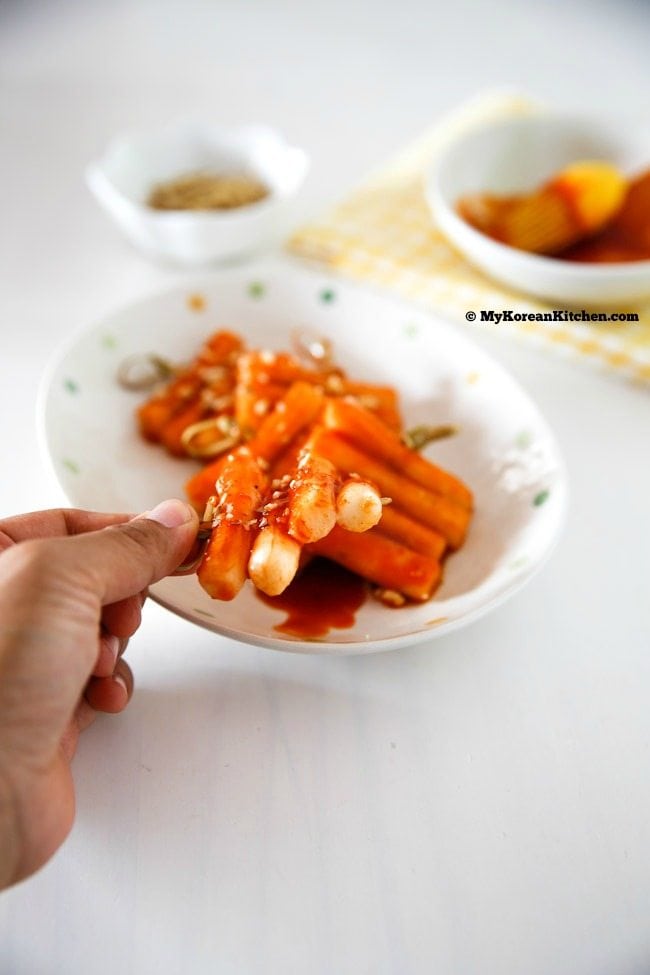
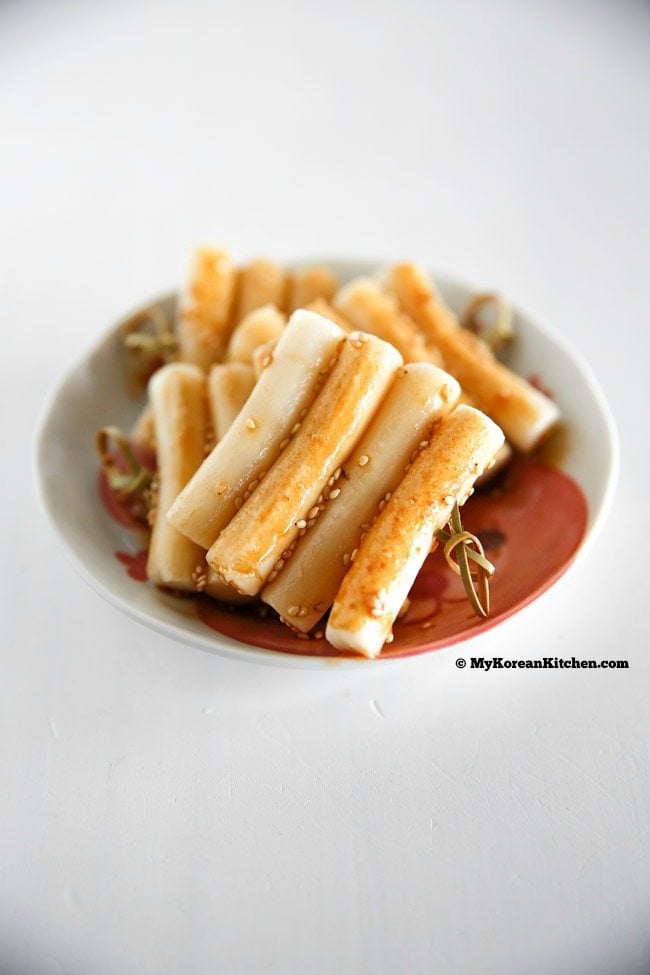
Love Korean food? Browse lots more Korean recipes from my easy Korean recipe collections. And subscribe to my newsletter for all of the latest updates including new recipes, what MKK communities are cooking and K-Dramas!

Korean Rice Cake Skewers (Tteok Kkochi)
Ingredients
MAIN
- 32 pieces Korean rice cakes (garaetteok)
- Some cooking oil , I use rice bran oil
- 1 to 2 Tbsp crushed nuts of your choice to garnish (I used walnuts. Peanuts, almonds or even sesame seeds are also a popular choice.)
SPICY, SWEET AND SOUR SAUCE (ORIGINAL STYLE) – MIX THESE IN A BOWL
- 1 1/2 Tbsp tomato sauce (ketchup)
- 1 Tbsp Korean chili paste (gochujang)
- 1 Tbsp honey
- 1/2 Tbsp soy sauce
- 1 tsp dark brown sugar
- 1 tsp sesame oil
- 1/4 tsp minced garlic
SAVOURY SWEET SAUCE (OPTIONAL, KIDS FRIENDLY STYLE) – MIX THESE IN A BOWL. THIS SAUCE IS ONLY ENOUGH FOR ABOUT 16 PIECES OF RICE CAKES.
- 1/2 Tbsp honey
- 2 tsp soy sauce
- 1 tsp sesame oil
- 1 tsp toasted sesame seeds
Instructions
- Blanch the rice cakes in hot boiling water for about 30 seconds to soften them. Drain the water and run cold tap water on the rice cakes. Drain and pat dry the rice cakes with some kitchen paper to avoid oil splash during cooking. (If your rice cakes are fresh and soft already, skip this step.)
- (While boiling the water above) Heat the sauce in a separate sauce pan briefly (for 20 to 30 seconds) to dissolve the sugar and honey and thicken the sauce a bit. Constantly stir it to avoid burn.
- Put the rice cakes on the skewers. (Number of rice cakes on the skewer will depend on the length of the skewer. But make sure that it will fit nicely in your frying pan.)
- Add some cooking oil in a well heated pan and grill both sides of the rice cakes on medium high heat for about 1 min each. Take them out and brush the sauce on both sides of the rice cakes. (Alternatively you can dip the rice cakes into the sauce bowl if it’s deep enough.)
- Garnish with your choice of crushed nuts and serve. Enjoy these delicious treats, either warm or cooled to room temperature.
Notes
- 1 Tbsp = 15 ml
Nutrition Info (per serving)
The nutrition information shown is an estimate provided by an online nutrition calculator. It should not be considered a substitute for a professional nutritionist’s advice.
